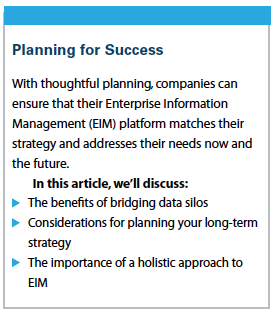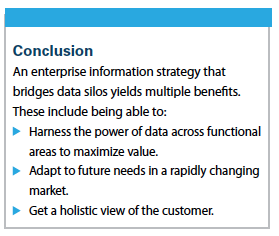 Pharma companies find themselves in a predicament when it comes to managing the volume and variety of client, product and other types of data that is vital to multiple functions across the enterprise. Instead of developing an enterprise-wide information management solution, they’ve allowed one-off solutions to multiply function by function, which has led to disparate data sets that drive different business processes, resulting in decisions that are poorly coordinated or ill-informed and potentially in conflict with one another.
Pharma companies find themselves in a predicament when it comes to managing the volume and variety of client, product and other types of data that is vital to multiple functions across the enterprise. Instead of developing an enterprise-wide information management solution, they’ve allowed one-off solutions to multiply function by function, which has led to disparate data sets that drive different business processes, resulting in decisions that are poorly coordinated or ill-informed and potentially in conflict with one another.
While emerging companies may not realize that they need an enterprise solution today, they need to consider scalability to support marketplace agility and growth. Enterprise companies, who already have legacy investments in enterprise solutions, often find that they are not agile enough to scale.
Bridging Data Silos
In today’s marketplace, an increasing volume of data is being collected from a variety of disconnected external and internal data sets,1 including retail prescriptions, social media, publications, CRM, Clinical Trial Management Software (CTMS), compliance and more.
This data needs to be accessed across business functions. When you have disparate systems, you’re:
Not serving the enterprise holistically.
Incurring escalating costs due to integrations and maintenance.
Hindering efficiency.
Creating barriers to the effective use of data.
Data Access Issues
Based on a recent study, 55% of life sciences companies consider themselves “very data driven." However, 74% are concerned about incomplete data, and 50% are worried that the insights gathered from this data aren’t actionable.2 The absence of clean, complete data and not knowing what to do with the data squander resources and open companies up to compliance risks. Data silos hinder insight development and limit productivity.
 This is where information management comes in. Information management is the process by which data is acquired from multiple sources, processed, and distributed to the right users at the right time. It’s imperative to deliver the data quickly via easy-to-use interfaces so it can inform day-to-day business decisions and regulatory reporting. Standardizing on a unified technology creates efficiencies and drives productivity gains by removing complexity in governing multiple systems.
This is where information management comes in. Information management is the process by which data is acquired from multiple sources, processed, and distributed to the right users at the right time. It’s imperative to deliver the data quickly via easy-to-use interfaces so it can inform day-to-day business decisions and regulatory reporting. Standardizing on a unified technology creates efficiencies and drives productivity gains by removing complexity in governing multiple systems.
A Fragmented Customer View
The customer journey has evolved from linear, brand-directed pathways to dynamic interactions that happen in real time across multiple channels and are increasingly driven by the consumer. Most marketers lack the capabilities to engage customers through this new journey, with data silos being a major obstruction. Bridging these silos will help provide a holistic view of the customer. A holistic, or 360-degree, view of the customer gives you a full sense of the customer’s value to the company, provides better insight into the customer, and facilitates better decision making for optimizing customer engagement.
The cost of a fragmented customer view — provider, patient or payer — includes:
Reduced sales and marketing effectiveness.
Inaccurate recruitment for clinical trials.
Inability to perform predictive modeling for segmentation or pricing or to capture new growth opportunities.
A well-thought-out strategy improves data access, supports a variety of business areas and results in increased commercial success.
Developing an EIM Strategy
Data fuels innovation and commercial success — but only if there’s a solid strategic foundation. Ultimately, your data management strategy needs to reflect your:
Business objectives.
Growth road map.
Considering your current business objectives in parallel with your growth road map will ensure that your solution meets your immediate needs and that any tools created for a single use case can be integrated in the future.
When developing a strategy, here are seven considerations.
Time Horizon
While it is important to quickly address short-term tactical needs, your company will benefit greatly by anticipating future needs. Questions to ask may include:
How quickly can you migrate existing data?
What use cases do you need to support in the near term?
Is there a modular approach you can use to add functionality and scale to meet the anticipated future needs?
To future-proof your strategy, you’ll need an EIM solution that can scale at the pace of change.
Scope
Emerging and enterprise pharmaceutical companies may have different business functions and use cases that they currently need to support. However, both must consider future requirements to craft an effective, long-term strategy. Additionally, both would benefit from a unified system that can continually accommodate an increasing volume of data and leverage it in innovative ways.
Companies will be well served to plan for growth and anticipate new ways to derive value from data to avoid:
Outgrowing limited functionality.
Introducing conflicting records that undermine a “single version of the truth."
Increasing complexity and governance costs.
It is vital to have a pathway to cross-functional access and broader utilization of data to serve future needs.
Location
An EIM solution can reside on your premises or “in the cloud," meaning that it is accessible via the web.
According to Gartner, cloud implementations have security advantages: they experience one-third fewer security failures.3
In addition to security, cloud deployments offer additional benefits:
Lower start-up costs
Faster setup
Automatic upgrades
Scalability
Immediacy
It’s important to determine how frequently your data must be updated and accessed to serve the immediate and future needs of business functions.
The industry is trending toward a more dynamic, enterprise-level model (versus scheduled) with regard to real-time data updates and access.
You can hone in on your organization’s specific needs by asking these questions:
How often is data currently updated?
Is data needed in real time or via pre-scheduled processing
What data governance processes are needed to continuously maintain and synchronize the master data repository?
Business Strategy
It is also important to consider the maturity level of your product strategy and the market dynamic it’s subject to.
What is the commercialization stage of your product or products?
What is anticipated in terms of market opportunity?
Is your product strategy well defined (i.e., relatively static) or evolving?
Companies often look to harness big data in order to identify trends so they can detect and react to emerging market signals.
Market maturity and rates of innovation increase the imperative for an enterprise approach.
Volume
Consider how much data you’ll be managing. Is it a relatively low amount that’s constant, or do you manage a high volume of data that’s expected to grow?
 The industry is trending toward a high volume of data from a variety of sources. Today, there are more than 15 petabytes of data in the healthcare industry!
The industry is trending toward a high volume of data from a variety of sources. Today, there are more than 15 petabytes of data in the healthcare industry!
When determining your needs, it’s important to ask yourself:
How much data is involved?
How many systems is the data coming from and going to?
Like most companies, do we anticipate needing to leverage a greater volume of data in the future?
Business Value
What is the business value your company is aiming for? Are you looking to fill immediate operational needs or make an organizational investment in a big data infrastructure?
The industry is trending toward an enterprise-level investment model due to the greater role big data is playing in the industry.
However, ask yourself:
What big bets do we need to make based on data analytics?
What is the cost of incomplete data for our organization? For instance:
Lost sales
Incomplete clinical trials
Regulatory fines
When determining the business value you’re aiming for, be careful to anticipate your future needs. The volume and uses of data are growing rapidly, so you need a single, flexible solution that allows you to aggregate new data more readily and generate different views of that data as needed. In other words, this kind of solution will grow with your needs and allow you to react quickly to a dynamic market.
A Holistic Approach
Once you’ve considered your business priorities, it’s time to lay the groundwork for implementing your strategy.
It is vital to find a partner that provides a holistic approach to enterprise information management that is strong in people, process, and technology.
People
Expertise in the pharmaceutical industry
Experience supporting line of business applications
Direct, on-the-job experience resolving the data-related challenges pharmaceutical companies face every day
Process/Governance
Repeatable best practices for cleaning, merging, maintaining and distributing data in a compliant fashion
Adept at instituting scalable governance processes
Technology
Cloud-based technology for maximum scalability, flexibility, and accessibility
Expertise building the data warehouses, data lakes, data marts and data hubs needed for enterprise information management
A holistic customer view is vital for today’s successful commercial operations because it can be used to better inform customer interactions and business decisions. This is made possible by a long-term plan and a flexible EIM platform. In a dynamic marketplace where the volume of data and the number of potential applications for it are growing rapidly, it is essential to have an enterprise information strategy that can evolve with your needs. (PV)
Editor’s Notes: Mr. Allelunas oversees the technology and services solutions in QuintilesIMS’s Information Management portfolio, including Master Data Management, Data Warehousing, and Specialty Data Integration, and Strategic and Advisory services
1 “Master Data Management," QuintilesIMS website, http://www.imshealth.com/en/solution-areas/healthcare-data-technology-applications/master-data-management; 2 Ajay Khanna, “7 Ways Compliance Will Deliver Operational Efficiencies in 2016," Pharmaceutical Compliance Monitor website, January 20, 2016, http://www.pharmacompliancemonitor.com/7-ways-compliance-will-deliver-operational-efficiencies-in-2016/10261/;3 Kasey Panetta, “Is the Cloud Secure?" Gartner website, January 23, 2017, http://www.gartner.com/smarterwithgartner/is-the-cloud-secure/.
QuintilesIMS delivers integrated information and technology solutions to drive healthcare forward.
For more information, visit quintilesims.com.


















